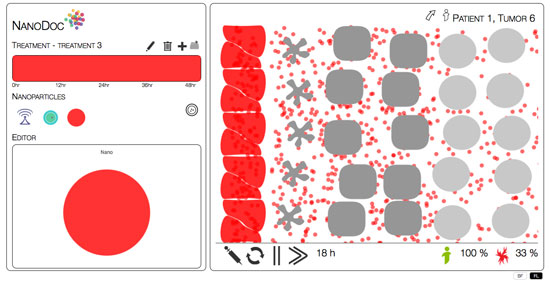| Sep 05, 2013 |
Nanotechnology online game to crowdsource the design of nanomedicines (w/video)
|
|
(Nanowerk News) NanoDoc is an online game that allows bioengineers and the general public to design new nanoparticle strategies towards the treatment of cancer. The nanoparticle simulator is built on years of research and experiments in nanomedicine at Sangeeta Bhatia’s laboratory at the Koch Institute for Integrative Cancer Research at MIT.
|
|
Watch the NanoDoc introduction video:
|
|
|
|
The first levels of the game will train you to become a NanoDoc.
|
|
Here is the introduction from the NanoDoc website:
|
|
Licensed NanoDocs will then be given challenges to solve. We don’t know what the best treatments are for these challenges, or even if there are any good solutions at all! We hope your drive to help in the fight against cancer and learn about nanomedicine will empower you to discover original, creative and efficient nanoparticle strategies we haven’t thought of yet.
|
|
Your simulated strategies will be the first step towards the design of new treatments which will require a lot of time and expertise before experiments can actually be conducted in the lab. To help translate your designs to reality, we’ve been working on specialized in vitro devices that can mimic how nanoparticles accumulate in tumor tissue. We also collaborate with Radhika Nagpal’s laboratory at the Wyss Institute – Harvard to test nanoparticle strategies on their large robotic swarm.
|
 |
| NanoDoc game screenshot
|
|
In the long term, we’re most interested in discovering ways in which nanoparticles can cooperate. In the teaser below, I’ve added a video showing simulated nanoparticles leaving a blood vessel (in red) to find a rare cell (with a pink border) in the tumor tissue. By smartly engineering the nanoparticles and how they interact with their environment, we’re able to mark direct paths from the vessels to the cell. These nanoparticles work in a way that is similar to ants forming trails to your picnic table by depositing information in the environment. One of the previous projects from our lab looked at communicating nanoparticles in mice, thereby showing the feasibility of cooperative strategies ("Nanoparticles that communicate in vivo to amplify tumour targeting").
|
|
In the upcoming weeks, we’ll be releasing new features that will allow you to create your own game levels. You can explore nanoparticle designs on your own, or submit your challenge to the crowd who will then be able to work on the problem together. We also hope to add new game levels and features that will allow us to consider nanoparticles with different charges, circulation times or that can be guided using magnetic fields or biological motors (flagella).
|
|
NanoDoc was designed at the Laboratory for Multiscale Regenerative Technologies, led by Sangeeta Bhatia, at the Koch Institute for Integrative Cancer Research at MIT. NanoDoc is funded through the Human Frontier Science Program.
|

